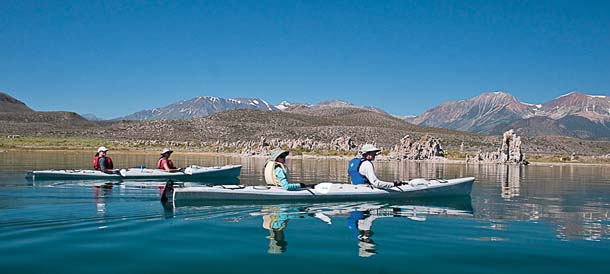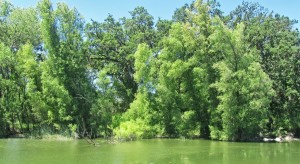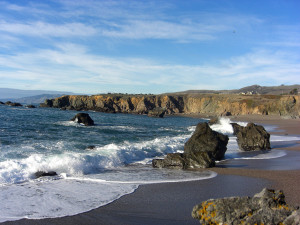Stark, wide-open Mono Lake–with its iconic tufa towers formed by the combination of carbonates in the salty lake and calcium from freshwater springs–is one of the natural wonders of California. Its abundant brine shrimp and alkali flies provide “an all-you-can-eat buffet for birds,” says park interpreter Dave Marquart. A majority of the California gulls in the state get their start here. Some 1.5 million eared grebes migrate through in the fall. Tens of thousands of phalaropes–Wilson’s and red-necked–summer here each year.
All told, the lake hosts some 80 migratory bird species, many of which travel huge distances. The Wilson’s phalaropes, for example, nest in the northern United States or Canada. After they’ve doubled their weight at Mono Lake, they fly nonstop to the coasts of Ecuador and Colombia.
These and other ecological riches earned Mono Lake Tufa State Natural Reserve a place on the state’s 2005 list of 29 parks with “the most outstanding natural resource values.” It doesn’t seem like the sort of place that would end up on a state park closure list–especially since it costs the state only about $60,000 annually. But when the list was published in May 2011, there it was.
- Kayakers on Mono Lake, with the Sierra Nevada in the background. Photo by David Wimpfheimer.
The U.S. Forest Service manages 180 square miles upland from the lake–Mono Basin National Forest Scenic Area–and a spiffy high-profile visitor center just off the highway. The state manages 70 square miles that include the lake itself, a bathtub ring of land around it, and two of the three access points. The feds and the state divide up tasks, with the state providing a volunteer program and signage, trail maintenance, and interpretation for adults and schoolchildren at all the lakeside accesses. Some 250,000 people visit the lake through those three access points every year.
When the closure list was announced, State Park and Forest Service staff almost immediately put their heads together with others, including representatives of the Mono Lake Committee advocacy group and the Bodie Foundation, which raises funds for three parks in the area, including the Tufa Reserve. They all suspected that the problem was the state park’s revenues, which stood out like a sore thumb–at zero. Parking fees were collected at the Forest Service’s South Tufa entrance, but no fees were collected at the two state-owned entrances.
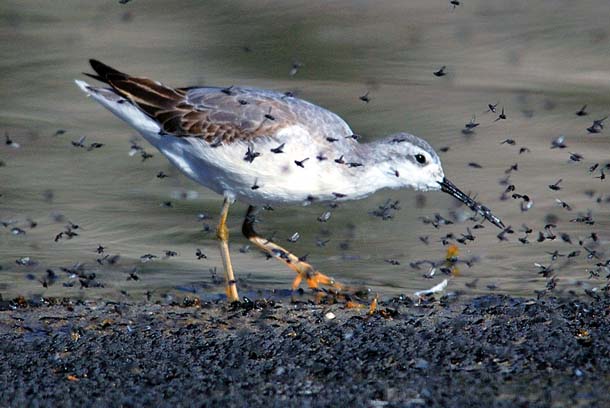
- The abundant alkali flies at Mono Lake make it an essential stop on the migration route for many birds, such as this juvenile Wilson’s phalarope. Photo by John W. Wall.
So parking fees were an obvious solution. The group proposed setting up a self-pay station at the popular Old Marina site, which was deemed the easier of the two entrances for collecting a $3-per-car parking fee. If the park staff were to collect these fees, they would go to the State Parks and Recreation Fund to be shared among all the parks. But in this case the Bodie Foundation would collect the money and put it in an account to be used for Mono Lake only.
The group’s next task was to convince officials in Sacramento that the scheme would work. An intense young man whose family owned a cabin in nearby Lundy Canyon turned out to be an important ally. Shortly after the closures were announced, he called the Mono Lake Committee and declared, “We can’t close this park!” Executive director Geoff McQuilkin told him what the committee was doing and where to send a letter. “But then we got to talking,” McQuilkin says. “It turned out he was the great-great-grandson of John Muir.”
The Muir relative was 31-year-old Robert Hanna. A former sales manager at a financial firm, he had just started an online business when the closure was announced. But he decided to drop everything and fight for the park.
Hanna remembered a hike he’d taken with a revered great-uncle at age 11. When they got to a particularly splendid place, the older man said, “Someday you will understand how important these places are to our family. And when these places cry out for help, you must answer their call.”
“At 11, I thought he was nuts,” Hanna says. “But when the closure list came out, I understood. These lands were crying out to me for the first time.” Soon he was helping McQuilkin and others with the Mono campaign: first crafting the proposal, then paddling around the lake with two members of the state Legislature, Assembly member Kristin Olsen (R-Modesto) and Senator Ted Gaines (R-Roseville). “I just knew I had to get them out there,” he says. “And they walked away saying, ‘Wow, we’re here to fight for you.'”
Once a proposal had been submitted, Hanna says, he called the state park headquarters in Sacramento every day at 9:30 a.m. “I just told them I’m not going away until it’s done.” Two months later, on December 1, Mono Lake was officially removed from the list.
“We showed that we will stand and fight for our parks,” Hanna said in a blog entry on his new Range of Light outdoor-clothing business website. “We also showed what can be accomplished by working together for something you love.”
Lately, Hanna has been advising and cheering on advocates at other parks on the closure list, including Benicia Capitol State Historic Park and Benicia State Recreation Area in the Bay Area and Castle Crags State Park near Mount Shasta. “I tell people to stay confident,” he says. “Don’t fall into the negativity of ‘I hate government’ and ‘how could they do this to us?’ We don’t have time for that right now; we need everybody clicking on all cylinders.”
Work is ongoing at Mono Lake, where park advocates are thinking about special events and other programs that could supplement the $30,000 or so the parking fee is expected to bring in. “Mono is a one-of-a-kind park that doesn’t have an ideal place to collect revenues,” says acting Sierra District Superintendent Matt Green. “Any unit in that category is going to be subject to scrutiny in difficult times.”
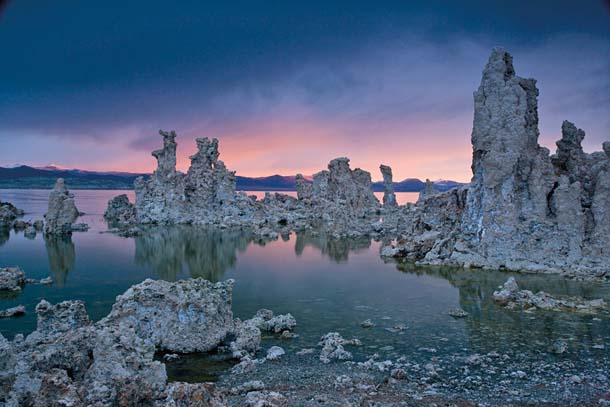
- Dawn light on tufa towers at Mono Lake. Photo by Julie Kitzenberger.
An Open Park’s Lament
The largest state park, Anza-Borrego Desert in Southern California, had the good fortune to not wind up on the closure list. Yet in the past few years, its budget has been steadily shrinking, forcing a reduction in staff from 44 to 22 and the closure of a third of its campground spaces. The remaining staff may soon need to start patrolling nearby Salton Sea and Picacho parks, which are on the closure list, on top of their own 600,000 acres.
“It’s really depressing for everybody,” says Anza-Borrego Superintendent Kathy Dice. “There’s no money to replace equipment or fix things. We’re down to counting paper clips.”
The May 2011 closure announcement was aimed at reducing pain for the remaining parks in the system. But of the $22 million to be cut over two years, about half will come from headquarters cuts and service reductions at those open parks, says state parks’ Deputy Director of Communications Roy Stearns.
“Our staff is scared,” Dice says. “We all know in our hearts there is nowhere left to cut.”

.jpg)
